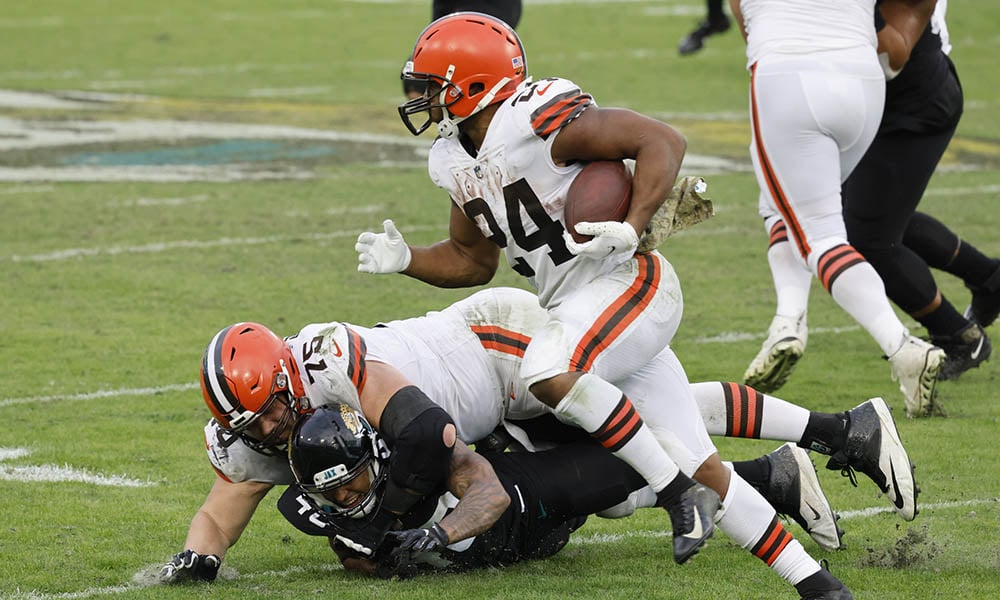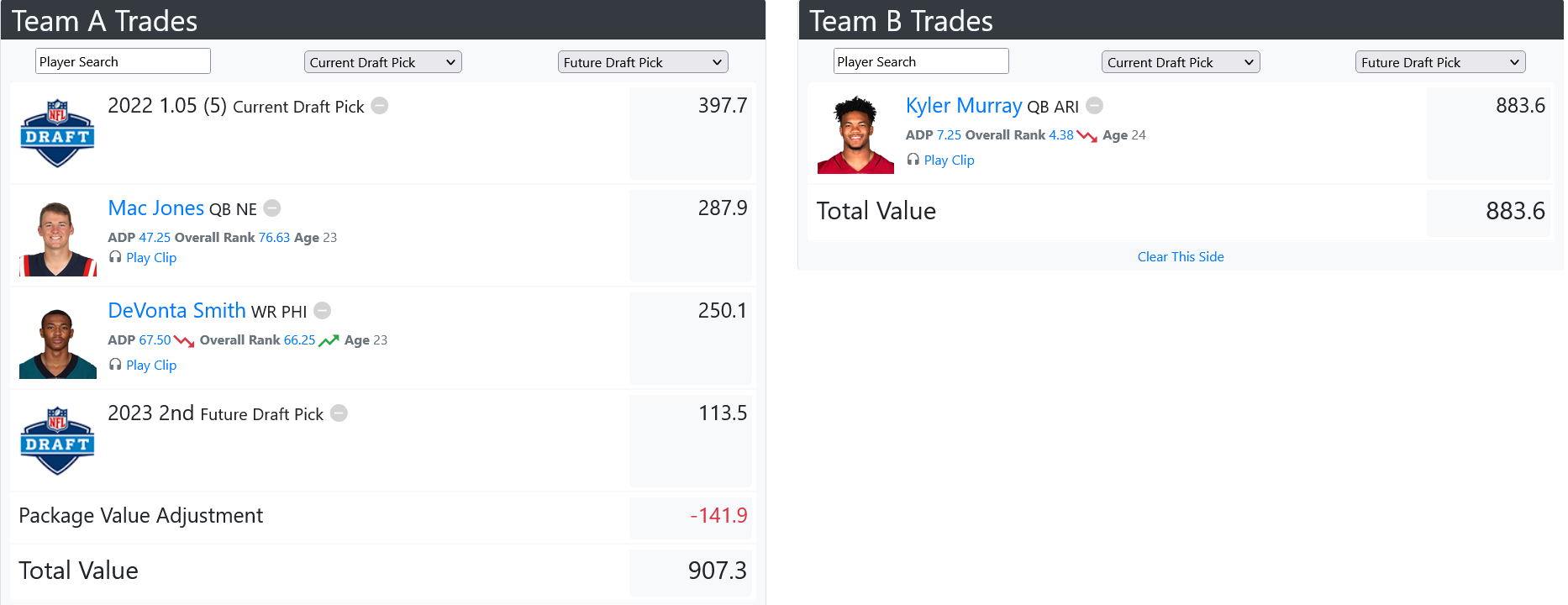Market Advice: Leverage Trades

Editors note: For the second straight year the team here at DLF created a Dynasty Draft Guide to help you dominate your leagues, no matter what format. The Dynasty Draft Guide provides you with breakdowns of specific players you should target or avoid in 2022, but more importantly, it also contains evergreen strategy articles that you can refer to even after the 2022 season concludes. Check out one of those articles below, and remember as a DLF subscriber you have access to the entire guide here.
Here we identify the highest leverage trade prototypes you can make based on the current market – this will feature current ADP data along with real-world trade examples to highlight why leveraging your position at any given time in dynasty leagues is a must.
Understanding Your Format
Before we get started, understand most of the examples and discussions are heavily dependent on the format of the league you are playing in. A quick search of the site archive on DLF is rich in resources on starting, maintaining, and navigating different types of dynasty leagues. The basics such as positional scoring, starting lineup requirements, in-season/off-season roster size, waiver rules, transaction deadlines, taxi squads, trade deadlines, and more are key in setting up a basic template of your strategy before the league even begins. Player values are not sticky and can vary greatly with different setups – this is often the most challenging part of a new league. Figuring out exactly what you want to do without even determining what players to select and where to select them. Ultimately, understanding the #Leverage and connecting the dots to where it exists in your league is a task to undertake before moving into proposing trades.
Defining Leverage
Leverage (noun) is defined as, “the action of a lever or the mechanical advantage gained by it and the use of credit to enhance one’s speculative capacity.” From the root word lever, picture a rock too heavy for you to move with your hands, possibly due to a limitation in your core strength. You grab a metal shovel, place one end under the rock and push down on the other end, lifting the rock far too heavy for you to budge previously. In dynasty terms, it is defined as, “using something additional to enhance your capacity.” Oftentimes we associate this “something additional” as knowledge not yet obvious and currently undervalued so we are willing to become more obvious and thus, find more appropriate value. You could refer to these as “bets.” We examine how you can take this concept to your dynasty leagues.
The 80/40 Break-Up Trade
Starting off with a bang. This could be a favorite and an absolute go-to move when you find a team needing additional assets or struggling to build ongoing capital. The basis of the strategy is taking a single asset (represented by 100) and turning it into two assets (represented by 80 and 40). Identify a place in the current dynasty market where the range of production outcomes does not match the cost. The “80” represents an undervalued asset that with a mild “upset” against the odds can end up with an equal or more favorable outcome than the “100.” The “40” represents pure upside or insurance thrown into the trade, oftentimes in the form of a future draft pick. For this example, look no further than the running back ADP.

In this trade, we have identified Nick Chubb (RB14, 26.1 years old) as a sell candidate for Leonard Fournette (RB30, age 27.0) and a 2023 mid-first round pick. In this case, Fournette’s value has fallen based on his age and uneven production throughout his career. Chubb’s value has held steady since the end of the season given he was signed to a contract extension last off-season. Fournette has averaged more points per game than Chubb over their careers and after four years of seeing Chubb average only 250 touches per season, the odds those touches drastically increase as he ages become less and less. Furthermore, Chubb’s 15.05 PPR points per game over his career would historically slot in at RB10 over the past decade – this provides fewer than three points per game more than the typical RB20. Assuming this holds true, Fournette may equal or exceed Chubb’s performance over the same number of years (considering their current age) and you gain a flexible draft pick you can be used over a longer period of time with minimal volatility.
The 2 For 2 Trade
This structure has proven to be an even more successful one for many over the years in terms since it’s a little easier to find trade partners. Ultimately, the deal involves two assets for two assets and there is something pleasing about getting back as many “assets” as you are giving away. The basis of this strategy is finding two assets, moving them for two other assets, and hoping you end up with a higher net value in the trade. This deal can be in the form of players or draft picks, often taking the form of betting how early or late a future pick will be compared to one that is currently defined and closer to being converted. For a further look, we examine the current WR landscape and production.

In this trade, we move Jaylen Waddle for DJ Moore and take the bet Moore can come close to or match Waddle in one of your wide receiver spots. The market views Waddle (WR8) as 1-2 rounds more valuable than Moore (WR14) and here we have identified this can be exploited. We make this bet in the form of sending a 2022 1.10 rookie pick in exchange for a 2023 1st. In most cases, this swap would not be possible without the addition of the wide receiver upgrade on the other side. Ultimately, the variance gap is much greater on players in a similar tier compared to a pick, already defined as the 1.10 in a weak class compared to a future, random pick in a strong 2023 class. This deal could be your go-to when the 80/40 Break-Up does not work and the other side is adamant about wanting an equal number of assets back in any trade. Finding places where the market overvalued how sure the production tiers actually are is the best spot to choose trade candidates from in this format.
The Coins For Dollar Bill Trade
A caveat for this discussion is understanding much of what we stated at the beginning regarding roster size, lineup requirements, and transaction rules as being crucial. As formats become deeper and lineup sizes expand, the desire to make this type of trade lessens. More than likely, this deal is preferable in formats with 11 or fewer starters and shallow enough rosters that the waiver wire can fill any vacated slots with something of minimal value. With that said, the idea of this strategy is exactly what it sounds like – add enough coins into the pot so you can cash them in for a dollar bill. The analogy is perfect as carrying four quarters takes up more space and weighs more than a folded-up dollar bill that you can stash anywhere. The same goes for dynasty when you identify a specific asset you want and look to acquire it by packaging at least three pieces together in the deal. For a further look, we examine the current QB landscape and strategy of building around two elite quarterbacks (see the Superflex 1-2 Combo startup section for more details).

In this trade, we move four pieces with the cumulative value slightly greater or equivalent to one single piece in quarterback Kyler Murray. More than likely, you have identified limitations in the assets being sent away in the trade and have made a “bet” that your predictions prove to be more correct than not. Ultimately, the team accepting a package trade like this may see the best-case scenarios on the assets they are acquiring and not understand they are also giving you two additional roster spots to work with. Not only could you achieve the intrinsic value of upgrading at the place you targeted for my build, but you also opened up multiple spots to now add anything of value off the waiver wire. This is not seen in any trade calculator but is often another aspect of this type of trade that proves beneficial. Try this deal when you have an already established roster and target teams looking to rebuild or re-tool their roster. Use current market values to find the assets and players that might fit the most plausible path to getting a deal accepted.
Conclusion
You may find yourself examining your leagues and looking at the numerous valuation resources on our website wondering how you can implement these trades. Ultimately, the players involved in the examples or anything you speculate using the Trade Analyzer is only that – speculation. The major takeaway from this article is understanding the trade strategies and the “why” behind them. We all have our own opinions, predictions, and bets when it comes to what will happen in NFL football. The next time you find yourself with an idea you feel strongly about, look to your dynasty rosters and incorporate that idea into a #Leverage trade offer.



































































